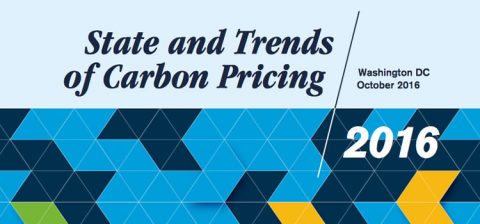
Tegengaan klimaatverandering kan veel goedkoper
20 oktober 2016 – Als het lukt een een goed werkend systeem voor het beprijzen van CO2-enmissies te realiseren, zullen de kosten van het tegengaan van klimaatverandering 30 tot 50 procent lager uit kunnen vallen. Dat meldt de Wereldbank in het rapport State and Trends of Carbon Pricing 2016.
Het rapport is opgesteld in samenwerking met Ecofys en Vivid Economics.
Uit het persbericht van de Wereldbank
‘(…) Greater cooperation through carbon trading could reduce the cost of climate change mitigation by 32 percent by 2030. (…) New modelling analysis undertaken for the State and Trends of Carbon Pricing 2016 report shows that increased international carbon trading could enable large-scale emissions reductions at much lower cost than at present, based on the carbon mitigation goals spelled out in countries’ national climate plans under the Paris Agreement — the Nationally Determined Contributions, or NDCs. By the middle of the century, an international market has the potential to reduce global mitigation costs by more than 50 percent.
The goal of limiting emission reductions to meet a 2°C or lower target will be difficult to achieve cost-efficiently without more carbon trading, according to the report. (…)
“The more we cooperate through carbon trading, the larger the savings and the greater the potential to increase ambition by countries in the short term,” said John Roome, Senior Director for Climate Change at the World Bank. “To be effective, carbon pricing policies must be coordinated with other energy and environmental policies –this will require collaboration within and between countries.”
The Paris Agreement, reached at COP21 in late 2015, sets up a framework for global cooperation through carbon markets. Over 100 countries consider carbon pricing initiatives as part of their NDCs, through emissions trading within or across borders, international crediting, carbon taxation and other measures. (…)
The report also shows that momentum on carbon pricing has continued to grow. In 2016, 40 national jurisdictions and over 20 cities, states, and regions are putting a price on carbon, including seven out of 10 of the world’s largest economies. The coverage of carbon pricing initiatives on global emissions has increased threefold over the past decade, translating to the equivalent of around 7 gigatons of carbon dioxide (GtCO2e), or about 13 percent of global GHG emissions. In addition, governments raised about US$26 billion in revenues from carbon pricing initiatives in 2015. This represents a 60 percent increase compared to the revenues raised in 2014. (…)’
Uit een persbericht van Ecofys
‘(…) 2016 saw the launch of two new carbon pricing initiatives in British Columbia and Australia. Overall, momentum continued to grow with now 40 national jurisdictions and over 20 cities, states, and regions putting a price on carbon. The coverage of carbon pricing initiatives on global emissions has increased threefold over the past decade, translating to the equivalent of around 7 gigatons of carbon dioxide (GtCO2e), or about 13% of global GHG emissions.
This figure could grow from 13% to 20-25% of global GHG emissions next year if the Chinese national Emissions Trading System and further initiatives will be implemented in 2017 as announced. The Chinese ETS would then surpass the EU ETS as the largest carbon pricing initiative in the world. (…)’
Uit een bericht van Wattisduurzaam
‘(…) Er zijn twee hoofdvormen van CO2-beprijzing; directe belasting of handel in emissierechten (ETS, Cap and Trade). Sommige landen gebruiken beide vormen naast elkaar. Voordeel van een belasting is dat het voor bedrijven en consumenten altijd helder is wat het kost om broeikasgassen uit te stoten. Dat maakt de winst van energiebesparing of hernieuwbare energie direct duidelijk en investeringsbesluiten eenvoudiger. Nadeel is dat er geen impliciet maximum aan CO2-uitstoot gekoppeld is aan de belasting; als de belasting niet genoeg afschrikt, veranderd er niets.
Een emissiehandelssysteem (ETS) stelt wel een plafond aan de uitstoot. Een autoriteit geeft certificaten uit die bedrijven het recht geven om een bepaald deel van dat maximum uit te stoten. Partijen die investeren in duurzame energie of besparing houden emissierechten over en kunnen deze verkopen aan bedrijven die meer uitstoten dan aan rechten is toebedeeld. Het idee van een ETS is dat het uitstootplafond met de jaren zakt en dat de marktprijs voor CO2 evenredig stijgt. Helaas zijn bestaande Cap-and-trade-programma’s, zoals het Europese ETS, gevoelig gebleken voor economische neergang en lobby uit CO2-intensieve sectoren. De marktprijs voor CO2 is sinds de invoering juist gekelderd tot enkele euro’s per ton. Onvoldoende om aan te zetten tot investeringen die het klimaat ten goede komen.
Groot voordeel van emissiehandel is dat lokale systemen in theorie goed te koppelen zijn tot internationale marktplaatsen. (…)
In de totale CO2-markt ging in 2015 zo’n $ 50 mrd om. $ 26 mrd daarvan kwam ten goede aan overheidsbudgetten. Hoewel het aantal fiscale regelingen voor CO2-reductie dit jaar stijgt, verwacht de Wereldbank een stabilisatie van het totaalbedrag dat in 2016 aan CO2-beprijzing wordt uitgegeven. Omdat de marktprijzen in de meeste lokale emissiehandelssystemen opnieuw zijn gedaald, blijft CO2-beprijzing ook dit jaar steken rond $ 50 mrd. (…)’
Bronnen
Worldbank, 18 oktober 2016: Global Cooperation through Carbon Markets Could Cut Climate Mitigation Costs Dramatically: New World Bank Report
Worldbank, rapport: State and Trends of Carbon Pricing 2016 (pdf, 138 pag.)
Ecofys, 18 oktober 2016: An international carbon market could reduce climate mitigation costs by a third by 2030
Wattisduurzaam, 19 oktober 2016: ‘Klimaattransitie de helft goedkoper met mondiale CO2-prijs’



